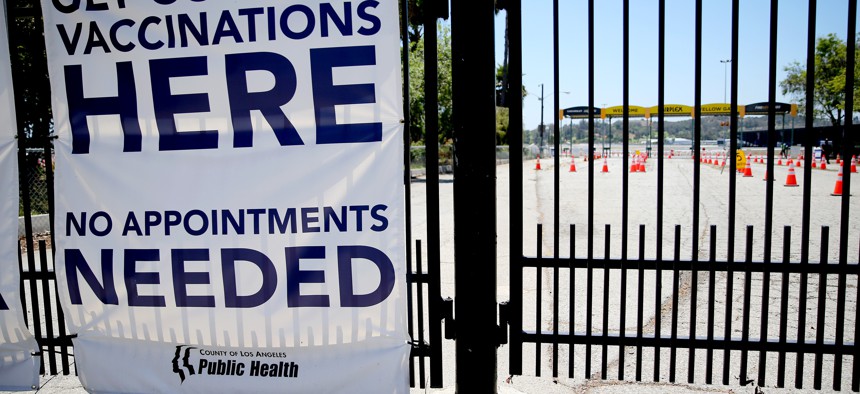Public Health Workers Still Fighting the Pandemic, Even as Policy Makers Move On

Photo by Mario Tama/Getty Images
"It's not over," warns Dr. Georges Benjamin of the American Public Health Association in an interview with Route Fifty.
After more than two years, many Americans have grown weary of the Covid-19 pandemic. But with the U.S. death toll topping 1 million and a highly transmissible subvariant spreading rapidly across much of the nation, public health officials urge continued caution.
On Wednesday, the Centers for Disease Control and Prevention advised Americans who live in areas with high transmission rates to wear masks indoors.
The uptick in infections comes as mandatory masking and other government Covid-control efforts have fallen away—as has some of the public health infrastructure designed to monitor the prevalence of the virus, such as mass testing sites and wastewater monitoring.
As executive director of the American Public Health Association, Dr.Georges C. Benjamin has been involved in pandemic response since the start. The association represents 50,000 public health workers and organizations.
In an interview with Route Fifty Wednesday, Benjamin reflected on the shifting nature of the pandemic, the lessons learned and his concerns about the future. Below is an edited version of the conversation.
Route Fifty: The current spike in cases signals that the coronavirus is still with us, despite the pandemic fatigue some Americans may be feeling. What’s your message to them?
Georges C. Benjamin: It’s not over. This disease is here and is probably here to stay. ... We’re going to have recurrent outbreaks for some time. And this disease continues to surprise us: Just when we think we understand it, it gives us a little twist.
As [Covid-19] continues to evolve, we should anticipate that we’re going to have to improve both our vaccines and the therapeutics we have.
And as a nation, we have to begin thinking about how we more effectively track this disease. We don’t have a good surveillance system.
The first year or so of this pandemic, there was a broad public policy effort to contain the disease and treat the people who got sick. For the next phase, we need to build a strong public health system ... so that we can take these episodic events and keep them contained.
Q: What can elected leaders and other government officials do to stop the spread of the virus now and strengthen public health in the future?
A: Policymakers are going to have to become more comfortable with changing their guidance on a rapid basis. That may mean that on Monday you get to do a bunch of things but by Thursday, you can’t.
We’re all going to have to make some adjustments and be nimble.
They need to provide leadership. My advice, which has been persistent throughout this pandemic, is that our elected leaders park all the politics; politics should not play any role in their decisions.
At this point, anyone who is denying that the disease is here, the seriousness of it or the fact that masks and vaccines do work has got to have their head in the sand. They’re just wrong.
Q: Given infections are climbing in some parts of the U.S., should leaders in those places reinstate mandatory masking?
A: Public officials have to be a little more thoughtful when they make mandatory orders or declare [public health] emergencies.
At the end of the day, your goal is compliance and if you’re more likely to get better compliance if you say ‘I think you should wear a mask’ instead of ‘you have to wear a mask,’ then I would argue we should do that. We need to use what we know about behavioral science to get people to comply, so I’m OK with recommendations over mandates. But if you can’t get good compliance, then you should go with a mandate. I think that process is going to ebb and flow for the next few years.
Q: What’s the mood of public health workers now?
A: The public health community is pretty frustrated by the lack of support from some policy makers and the fact that people are going after public health [workers’] legal authority.
A lot of money has been put on the table [to address the pandemic] but money doesn’t build sustainable systems. The lack of support systems [for public health] has been very concerning to me.
Q: Are you worried that a lot of the public health infrastructure the U.S. built to quickly address the crisis—things like mass testing and free vaccination sites—has disappeared?
We’re not building anything in meaningful ways for the long haul. We do not have a federally funded and supported national vaccination program for adults.
My fear is that one day, we’ll get another really bad bug ... and all of a sudden we’ll be back at ground zero again. That’s what I’m worried about.
Daniela Altimari is a reporter for Route Fifty.
NEXT STORY: States Have Yet to Spend Hundreds of Millions of Federal Dollars to Tackle Covid Health Disparities





